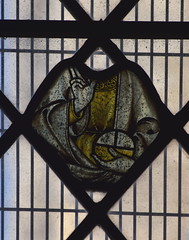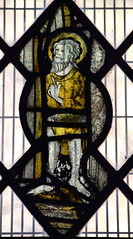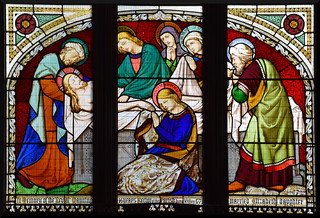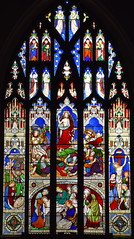| |
|
St Mary,
Diss If anyone was to ask me
which town is the most typical of Norfolk, I would
certainly say Diss. It is ancient, quirky, predominantly
working class. Its people are friendly yet reticent,
politically conservative, socially liberal, welcoming but
uncompromising. Its architecture is utilitarian, with
glimpses of sudden loveliness that make you gasp.
Sir John Betjeman loved Diss above all East Anglian
towns, and often said he was more proud of being
president of the Diss Society than he was of being Poet
Laureate. His friend Mary Wilson, a minor poet and the
wife of the Prime Minister of the day, had been brought
up in Diss. He wrote to her: Dear Mary, yes, it will
be bliss, to go with you by train to Diss...
In the 1970s there was a local lobby for Diss to be the
centre of regional government in the east of England,
sitting as it does exactly halfway between Norwich and
Ipswich. Whitehall smiled and nodded, and then sensibly
opted for Cambridge, reasonably considering that one
shouldn't allow such things as regional government to get
too far out of ones grasp.
Diss had become a backwater in the 17th and 18th
centuries, and no major fire led to its rebuilding as at
Bungay, Beccles and other places in the Waveney valley.
Because of this, Diss is second only to Sudbury in having
more surviving medieval houses than any other town in
East Anglia of its size. The other feel of the place is
19th century, because Diss was a railway town, and still
is. Tudor and Victorian architecture is a happy
combination, and Diss retains narrow streets and cobbled
yards that have been bulldozed elsewhere.
More recently, European money funded a major refurbishing
of the Mere area (did I mention that Diss is the only
market town in England built around a large lake?) and
the town took part in CittaSlow, a European-led
project for small towns which aimed to keep fast cars and
fast food out, making the streets safe for pedestrians,
pavement cafes and good food. And right in the heart of
the town, hemmed in by narrow streets and leaning 16th
century buildings, is the great church of St Mary.
The massive rebuilt Victorian chancel detracts from the
nave, but this is also huge, and largely the product of
the late 15th century. The attention to detail on the
buttresses is remarkable, for every one of them has a
pedestal in the form of an animal that once supported an
image of a Saint. It must have been quite a sight. The
14th century tower has a processional archway through the
base as at St Peter Mancroft in Norwich or St Lawrence in
Ipswich, and the tower has a wooden fleche turret
dating from 1906.
This, then, is a grand, urban church, central and
essential to the townscape. Its churchyard is crossed by
pathways that lead between the market square and the
houses beyond the church, so there is constant pedestrian
traffic. Like all great urban churches (burghers of
Thetford and Haverhill take note!) St Mary is open all
day, everyday, and is well-used. Not once on my visits
have I ever been alone inside, and when I first came here
at 10.30 on a Wednesday morning back in 2005 a mid-week
eucharist was just beginning. There were about thirty
people in the congregation, and I could not think of many
small town Anglican churches that could attract such a
large congregation on a weekday. I might have imagined
myself in a Catholic church.
Being a grand, urban church, I am afraid that St Mary is
almost entirely Victorian inside. I do not know who the
architect was, but I thought I detected the hand of
Richard Phipson, responsible for the refurbishment of St
Peter Mancroft and the complete rebuilding of St Mary le
Tower in Ipswich. He would have been diocesan architect
at the time, so whatever plans were made here would have
passed through his hands in any case. There are a few
medieval survivals - but very few. They are exquisite
little panels of 14th and 15th century glass, handily set
in the west window of the south aisle so you can get them
out the way before you enter into the Victorianism of it
all. A pretty girl wears a garland of flowers. A bearded
man sits in a chair. A crowned woman in a kennel
headdress gazes up piously. St John the Baptist points, a
king looks wise, a tonsured priest scowls. Mary Magdalene
holds her pot of ointment, and a Blessed Virgin and
child, so faded as to be transparent, seem to be barely
there. They are the ghosts of medieval Diss.
   
   
There are two piscinas in the south
aisle, one of them 13th century, about four metres short
of the east end, and a 15th century one further east. The
first piscina obviously marks the end of the original
aisle before the 15th century extension. Everything else
is post-Reformation, so this is essentially an Anglican
church. There is a remarkable decalogue board on the west
wall which I take to be 18th century, but the
overwhelming impression here is of the 1860s and 1870s,
which brought the grand sanctuary and east window, the
furnishings and, most of all, the glass.
Virtually every window in the
church is filled, the nave with run of the mill stuff by
Ward & Hughes, glass that is fairly typical of any
urban church enthusiastically restored in the 19th
Century. Taken in isolation they are like illustrations
in a Victorian child's manual of religious instruction,
and perhaps the more charming for that. I imagine that
seats near to the one of the wise and foolish virgins
must have been popular with late-Victorian men keen to
have something to gaze at during the sermon.
The glass in the chancel is quite something else. It is
by Francis Oliphant, and Pevsner considered it an
important work. The scenes of the nativity and the
entombment in particular are worth a look. There are a
couple of other very interesting 19th century windows in
the chancel and south aisle chapel, but unfortunately
some of the best, including another Oliphant, were
removed in 1980 in an attempt to make the chancel
lighter.
 
A couple of curiosities. There are
an unusually large number of 19th century brasses around
the walls, so perhaps this was a significant local
industry in those days. Most are to the Manning family,
who provided rectors for most of the 18th and all of the
19th centuries. One of them was the first Englishman into
Tibet. There is a large early 18th century tombchest in
the north aisle to one Richard Burton. The lengthy
inscription is worth a read. He left a hundred pounds,
and the interest of this was to go to the parish for the
work of maintaining his tomb. Any money left over was to
be given to the poor of Diss. However, if his executors
felt that the tomb was not being maintained, then the job
and the money were to default to the parish and poor of
neighbouring Roydon instead. Hedging his bets still
further, Burton's inscription then goes on to say that if
Roydon isn't up to the job, then the benefit will fall to
Bressingham, the next parish out. I have to say that the
tomb is in a splendid state, but it isn't clear whether
this is the work of Diss, or Roydon, or Bressingham.
To finish, it is worth saying that Diss is as proud as
any small town is of its famous son and daughters. An
expansion in housing around the town in the last thirty
years has left plenty of scope for naming new roads. The
aforementioned Betjeman, Wilson, Manning and Burton have
all been immortalised, and other commemorated Diss people
include another Poet Laureate, John Skelton, probably the
most idiosyncratic voice of 16th century poetry. He was
remarkable for his compassion, and his enthusiasm for
inventing words, for which Keats and Auden both claimed
debts. He was the Catholic parish priest here for thirty
years in pre-Reformation days, and once stood in the
pulpit holding up what the church guide charmingly calls
a 'love-child', claiming it as his own, and defying the
congregation to find fault with it, its mother or with
him.
John Wilbye, the Elizabethan composer of madrigals, came
from Diss. Thomas Paine is more usually associated with
Thetford where he was born, but he lived in Diss for
twenty years, and perhaps learned his radical politics
here, for Diss in the 18th century was a hotbed of
non-conformism.
A mark of how civilised this town is can be seen even out
in the anonymous roads of the new estates, where many of
the street signs include a brief explanation of the
person or event the road is named after. Living in Diss
must be an education in itself.
Simon Knott, September 2018
Follow these journeys as they happen at Last Of England
Twitter.
|
|
|
